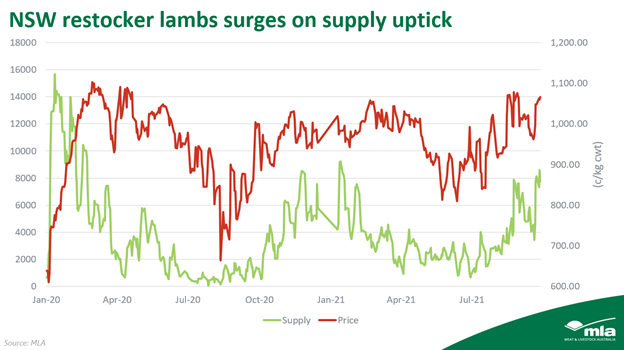NSW restocker lamb prices surge
Key points
- National flock growth well supported by NSW producer demand for restocker lambs
- The NSW restocker lamb price has appreciated 137c since the middle of July on the back of a supply uptick of 81%
- The number of sheep processed in NSW has risen 61% on a month ago, demonstrating capacity to mitigate Victorian processor reductions
Supply uptick does little to dampen NSW restocker lamb demand
In encouraging signs for the continuation of national flock growth driven by the strength and scale of the NSW sheep industry, restocker lambs in the state are in high demand. As supply in recent weeks has risen in line with the spring flush coming online across the eastern seaboard, price has also lifted with spring beginning to take shape across the state (see graph below).
Since the middle of July, restocker lamb supply in NSW has risen 81%, or 6,278 head. At the same time, the restocker price has appreciated 13%, or 137c, to currently sit at 1066c/kg cwt.
This demonstrates the increased supply of new season restocker lambs following the winter lull has done little dampen producers demand to purchase these lambs to grow flock numbers by capitalising on strong spring pasture growth and milder forecast temperatures.

NSW processors pick up the Victorian shutdown slack for sheep
Sheep numbers in NSW at the processing facilities remain buoyant, providing significant support for their Victorian counterparts’ shutdowns.
Traditionally, Victoria processes around 41% of total sheep volumes per annum. At present, with an expected 30% reduction in sheep slaughter volumes for Victoria due to COVID-19 forced reductions, NSW has continued to lift its slaughter volumes. Compared to the same week a month ago, NSW has increased its slaughter volumes by 61%, or 24,000 head.
This was the week in which the Victorian government introduced the enforced reductions. While Victorian volumes have remained firm, the supply of sheep at the saleyards has increased incrementally in line with the seasonal uptick in supply which was discussed in last week’s article. This demonstrates the capacity NSW has to assist Victoria in coping with increased numbers of sheep supply to the end of the calendar year.



